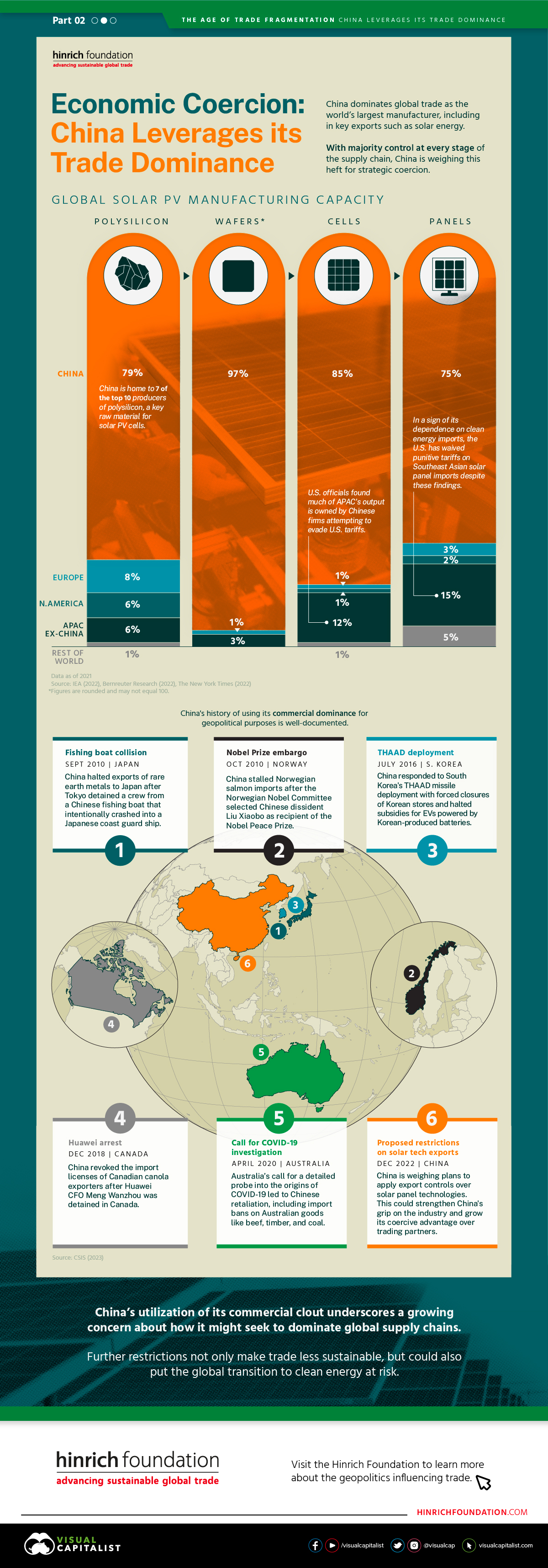
Published
2 hours ago
on
June 28, 2023
| 41 views
-->
By
Marcus Lu
Graphics & Design
- Sabrina Fortin
The following content is sponsored by The Hinrich Foundation
Economic Coercion: China’s Leverage in Trade
China’s rise as a global economic superpower has brought with it an ability for the nation to utilize its economic dominance for geopolitical purposes.
In this infographic sponsored by The Hinrich Foundation, we explore China’s dominant position in the solar photovoltaic (PV) supply chain, and how this could be used as leverage against countries that are dependent on it for clean energy.
Dominance in the Solar Supply Chain
Solar energy is playing a significant role in the green energy transition, and as this infographic shows, China’s dominance in the sector is clear.
| Economy | Polysilicon | Wafers | Cells | Panels |
|---|---|---|---|---|
| China | 79% | 97% | 85% | 75% |
| Europe | 8% | 1% | 1% | 3% |
| North America | 6% | 0% | 1% | 2% |
| APAC | 6% | 3% | 12% | 15% |
| Rest of World | 1% | 0% | 1% | 5% |
The solar PV supply chain starts with polysilicon, a key raw material needed to create wafers. China is home to seven of the top 10 producers of polysilicon, which includes companies like Tongwei Solar and Asia Silicon.
Where China is most dominant though, is in the manufacturing of wafers and cells. This is partly because it’s more economical to make these components close to wherever polysilicon is being produced.
The second-largest producer of cells and panels is the APAC region (ex-China), at 12% and 15% of total capacity. However, according to U.S. officials, much of this output is actually owned by Chinese firms attempting to evade U.S. tariffs.
While these companies would normally be subject to higher tariffs, the Biden administration has paused any tariff increases for the next two years. This can be interpreted as a sign of the country’s dependence on China for clean energy infrastructure, which could prove problematic given China’s history of economic coercion.
Leveraging Trade for Geopolitical Purposes
The second part of this infographic highlights past instances where China has used its commercial dominance for geopolitical purposes.
For example, in October 2010, the Norwegian Nobel Committee awarded the Nobel Peace Prize to Liu Xiaobo, a jailed Chinese dissident. China began stalling Norwegian salmon imports in response, and Norway’s market share of salmon exports to China fell from 92% in 2010, to 29% in 2013, according to the Financial Times.
China took similar actions towards Australia in April 2020 after the island nation called for a detailed probe into the origins of COVID-19. Import bans on Australian goods like beef, timber, and coal were announced in retaliation. These restrictions were eventually lifted in May 2023.
Given the massive size of China’s economy, import bans such as these can heavily impact a trading partner’s industries.
More recently, China announced in December 2022 that it would be looking into new export controls over solar panel technologies. Given China’s already tight grip over the solar PV industry, this move could expand the nation’s playbook when it comes to economic coercion.
This graphic is the second in a three-part series by The Hinrich Foundation that covers the geopolitics of trade.

Please enable JavaScript in your browser to complete this form.Subscribe to our free newsletter and get your mind blown on a daily basis: *Sign up
Related Topics: #geopolitics #US #climate change #global trade #china #energy transition #solar energy #Hinrich Foundation #trade #clean energy #economics
Click for Comments
var disqus_shortname = "visualcapitalist.disqus.com";
var disqus_title = "Economic Coercion: China's Leverage in Trade";
var disqus_url = "https://www.visualcapitalist.com/sp/economic-coercion-chinas-leverage-in-trade/";
var disqus_identifier = "visualcapitalist.disqus.com-159094";
You may also like
-
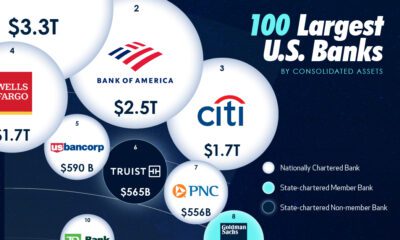
Markets2 days ago
Visualized: The 100 Largest U.S. Banks by Consolidated Assets
In this visual we showcase the relative size of the 100 largest U.S. banks in terms of consolidated assets.
-
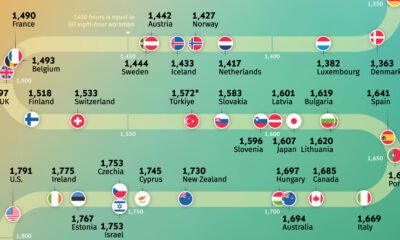
Jobs1 week ago
Visualizing Annual Working Hours in OECD Countries
Where do people work the most? Explore our analysis of the average annual working hours across OECD countries.
-

Cities2 weeks ago
Ranked: The Most Affordable U.S. Cities for Home Buyers
There’s more to consider than the price tag when purchasing a house. This ranking reveals the most affordable U.S. cities for home buyers.
-
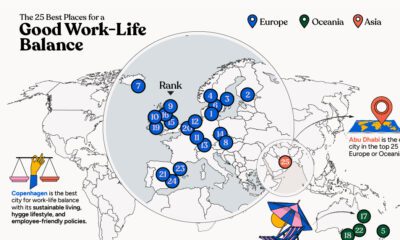
Misc2 weeks ago
Ranked: The Cities with the Best Work-Life Balance in the World
In this infographic, we explore which cities around the world excel in prioritizing work–life balance.
-
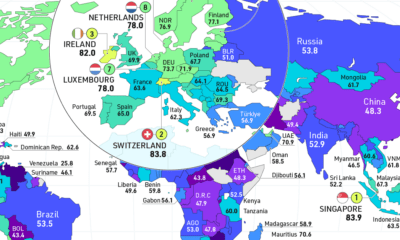
Economy3 weeks ago
Mapped: The State of Economic Freedom in 2023
How free are people to control their own labor, property, and finances? This map reveals the state of economic freedom globally.
-
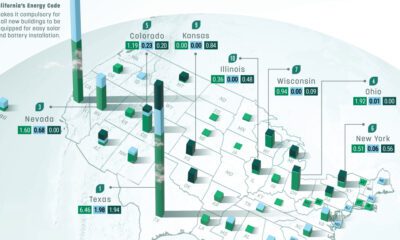
Maps4 weeks ago
Mapped: Renewable Energy and Battery Installations in the U.S. in 2023
This graphic describes new U.S. renewable energy installations by state along with nameplate capacity, planned to come online in 2023.
Subscribe
Please enable JavaScript in your browser to complete this form.Join the 380,000+ subscribers who receive our daily email *Sign Up
The post Economic Coercion: China’s Leverage in Trade appeared first on Visual Capitalist.